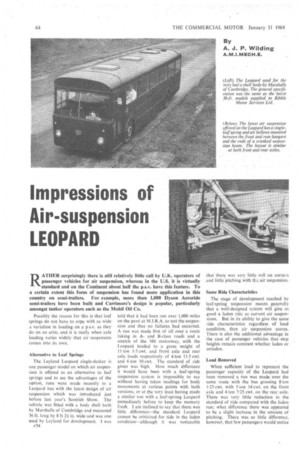Impressions of Air-suspension LEOPARD
Page 66

If you've noticed an error in this article please click here to report it so we can fix it.
RATHER surprisingly there is still relatively little call by U.K. operators of passenger vehicles for air suspension, whereas in the U.S. it is virtually standard and on the Continent about half the p.s.v. have this feature. To a certain extent this form of suspension has found more application in this country on semi-trailers. For example, more than 1,000 Dyson Aeroride semi-trailers have been built and Carrimore's design is popular, particularly amongst tanker operators such as the Mobil Oil Co.
Possibly the reason for this is that leaf springs do not have to cope with as wide a variation in loading on a p.s.v. as they do on an artic, and it is really when axle loading varies widely that air suspension comes into its own.
Alternative to Leaf Springs The Leyland Leopard single-decker is one passenger model on which air suspension is offered as an alternative to leaf Springs and to see the advantages of the option, runs were made recently in a Leopard bus with the latest design of air suspension which was introduced just before last year's Scottish Show. The vehicle was fitted with a body shell built by Marshalis of Cambridge and measured 36 ft. long by 8 ft 2+ in, wide and was one used by Leyland for development. I was
(14
told that it had been run over 1,000 miles on the pave at M.1.R.A. to test the suspension and that no failures had occurred. A run was made first of all over a route taking in Aand B-class roads and a stretch of the M6 motorway, with the Leopard loaded to a gross weight of 11 ton 1-5 cwt. and front axle and rear axle loads respectively of 4 ton 11-5 cwt. and 6 ton 10 cwt. The standard of ride given was high. How much difference it would have been with a leaf-spring suspension system is impossible to say without having taken readings for body movements at various points with both versions, or at the very least having made a similar run with a leaf-sprung Leopard immediately before to keep the memory fresh. I am inclined to say that there was little difference—the standard Leopard cannot he criticized for ride in the laden condition—although it was noticeable
that there was very little roll on corners and little pitching with th-z air suspension.
Same Ride Characteristics The stage of development reached by leaf-spring suspension means generally that a well-designed system will give as good a laden ride as current air suspensions. But in its ability to give the same ride characteristics regardless of load condition, then air suspension scores. There is also the additional advantage in the case of passenger vehicles that -step heights remain constant whether laden or unladen.
Load Removed
When sufficient load to represent the passenger capacity of the Leopard had been removed a run was made over the same route with the bus grossing 8 ton 1-25 cwt. with 3 ton 14 cwt. on the front axle and 4 ton 7.25 cwt. on the rear axle. There was very little reduction in the standard of ride compared with the laden run; what difference there was appeared to be a slight increase in the amount of pitching. There was so little difference, however, that few passengers would notice




















































































































